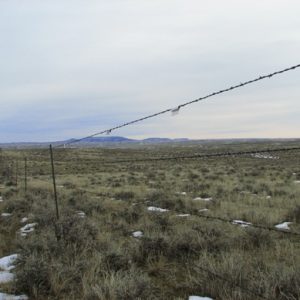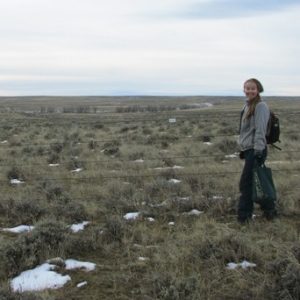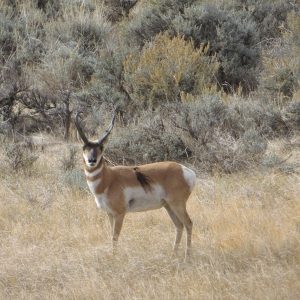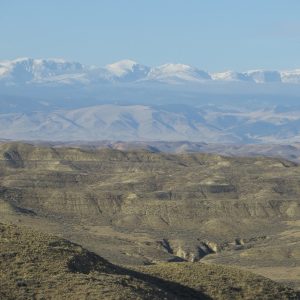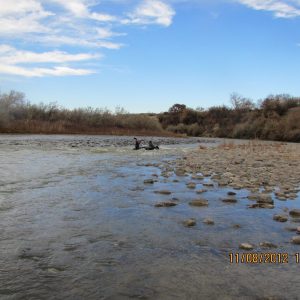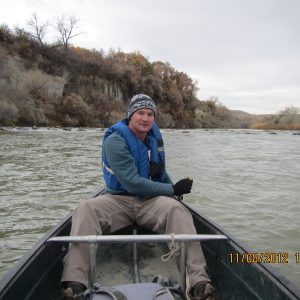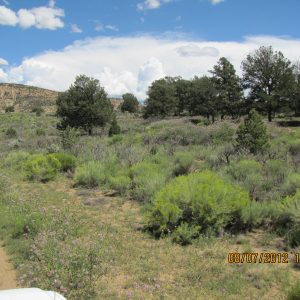With field season over, I am getting to join in with other members of the office in their field work and experience what a federal employee does. I got to see a wild horse round-up which was very interesting, and quite a procedure – helicopters and all! There is also lots of data organization and computer stuff to do, but that’s all part of working in a digital world. Happy Thanksgiving everyone!
Daily Archives: 19 November, 2012
Fire!
The past few months have been quite hectic here at the Eagle Lake Field Office in Susanville, CA. In August, a wildfire ignited over 300,000 acres of our field office. As soon as the fire was declared contained, our office began working on the Emergency Stabilization and Rehabilitation Plan for the fire. I put my CLM internship on hold and was hired by the BLM for two months to help work on this plan. There was an immediate need for detailed maps of the fire area so that the resource advisors could check out the aftermath and do their jobs more efficiently. I was thrown into ArcMap with only a little knowledge of the program and was forced to learn how to use it. This is a very effective way to learn a program quickly, and with the help of the other intern, I am now able to swiftly create good-lookin’ maps and run analyses on data in ArcMap.
Coming from the Midwest, I have no experience with wildfires at all. Susanville was blanketed in smoke for a month or two while the 300,000 acre Rush Fire as well as 2-3 other significant sized fires surrounded the town. Wildfires are definitely a humbling event and it was interesting to see everyone’s different reactions to them. Some of my co-workers were in tears over the damage that it was doing to the land, while others were rooting for it to burn more. Having experience using prescribed fires to manage resources in Indiana, my initial reaction was that the fire was a good thing and that the plants would bounce back quickly and with great vigor. I soon learned that there is a key issue that must be considered when a wildfire rages through the West: cheat grass.
I became familiar with cheat grass very quickly when I moved to California back in May. It’s everywhere; and where it’s a little more sparse, it’s always threatening to encroach on and crowd out the native bunch grasses and other native plant species. There is great fear that the burned areas that were once dense sagebrush habitat will turn completely to cheat grass, and will stay cheat grass. The invasive grass species has completely changed the fire regime for the sagebrush habitat so that fires occur more frequently. The native brush does not have a chance to establish itself before the next fire rolls through the cheat grass fields. You can easily pick out where past fires have occurred from the large patches of yellow in the landscape where nothing but cheat grass is growing. It is startling to look at the fire history data and see that the field of grass is the exact fire perimeter of a past wildfire.
This fire has opened my eyes to the severe need for native seed to be used for fire rehabilitation and the importance of the SOS program. Most of fire area did not burn that hot, so the roots of native grasses are still intact and have high potential to bounce back and successfully outcompete cheat grass. However, some areas got completely cooked and are more susceptible to cheat grass invasion because of the loss of the native seed bank. In these areas, seeding with native plant species is very beneficial to help keep out cheat grass. The SOS program is an excellent way to ensure that there is enough seed available for fire rehab (which was definitely an issue this year with all the wildfires that occurred) and that the seed used is native.
My BLM position ended recently so I have resumed my CLM internship. The BLM position was an excellent opportunity and I am very thankful that the CLM internship is so flexible and helped facilitate it. I am now looking forward to the challenge of finding and collecting viable sagebrush seed to help out with the Rush Fire rehab.
Last post – Thanks for a great internship
My internship in Idaho is wrapping up. But I will continue to stay in Boise, as Lichen Curator at Boise State University through May or early June. I will continue to work on the same projects. I’m excited to stay and see the completion of the digitization of the lichen and moss records. Once that is complete, I will have the chance to finish some other projects, such as mailing off duplicate specimens. Boise, Idaho is growing on me, and I’m glad I have the opportunity to stay a bit longer. And unlike last winter, this year I am prepared for the cold weather, and have a bike to get around.
One of my last field days, myself and 4 coworkers drove out to an ACEC that has a rare sedge. It was thought extinct for many years, and then a graduate student randomly collected it, almost 100 years after it was first described. A road had been placed through the site. So we planted small sedge plants in the old road bed, to encourage the sedge growth. It was nice to feel that I made a difference, and I hope this small project goes a long way towards preserving this species. This sedge is only known from 2-3 sites in Idaho. However, my coworker, Pam, says there are probably more sites. Its stunning to think that in these large tracks of land, how much needs to explored. Even 10 months into my internship, it’s still hard to grasp how large and vast this country is.
Last month, a past CLM intern flew into Boise, Idaho to visit friends she made from her internship. Roger took us two and an additional past CLM intern out to lunch. It was very neat to have 3 interns in the same room, and I’m sure I’ll be back to visit the friends I made in Idaho in the future.
In other news, I am close to submitting an academic paper that my supervisor, Roger Rosentreter and I have been working on since June. It will be quite an accomplishment to finally submit it.
Sagebrush Seed & Sage-Grouse Markers
Every month when it comes time for me to write my blog I find, without fail, that I am astounded by the experiences I have had and the skills I have gained through this internship program. Last week we had a Conservation Corps Crew from Montana visiting our field office and we were able to get out several days with them to collect Artemisia tridentata ssp. wyomingensis seeds. It was a HUGELY productive week for us and a lot of fun to get to work with a team of highly motivated, like-minded individuals. It was great to hear the crew members stories and reflections about the conservation projects they worked on up in Montana. With the crew’s help, we were able to collect mind boggling amounts of seed, much of which will be used to re-seed previously burned sites in our field office.
This week was also an exciting week for Hillary (the other CLM Range Intern here) and myself because we were able to put out the first of thousands of freshly made sage-grouse fence markers. It is a truly great feeling to successfully go through the process of having an idea, making a plan, and then implementing that plan in the field. After weeks of mapping fence line, researching sage-grouse fence markers, and then making markers of our own, it is fantastic to be able to start marking fences in core sage-grouse habitat. We hope this effort will reduce sage-grouse fence collisions, which have been found to be responsible for 40% of total species fatalities.
We need a bigger table…
As we’re on the doorstep of Thanksgiving (at the time this was written), I felt it would be fitting to [attempt to] try and compare management and policy implementation to Thanksgiving dinner. Turkey is great, but a meal, it does not make. You need stuffing as well, probably some sort of potato dish (or 3), gravy, rolls, cranberries, blah, blah, yadda yadda – You get the picture.
It’s similar to creating and implementing actions and management plans for land use, wildlife, and resources, etc. Timing restrictions near sage grouse leks, a conservation plan does not make. You need habitat protections, and improvements. You need seasonal habitat ranges identified. You need a cornucopia (see what I did there?) of information at several different scales, and all the while, you still need to manage for other land use/purposes (recreation, minerals, etc.). Protection around winter roost sites alone doesn’t satisfy all there is to eagle protection, the same way if I slapped down a tofurkey and some green beans, you’d probably (and deservedly) label it one of the worst Thanksgiving dinners… ever (subtle message to some of you, leave your tofurkey at home).
And that’s just addressing the ingredients. A huge spread while eating it alone, a Thanksgiving meal, it does not make. Without different offices and agencies all cooperating and doing their best to address and identify a common goal to work towards, these plans can easily fall short. It’s important to keep in mind; one can clean the bird, while the other cooks it. I’ll peel the potatoes and you mash them. You distract so-and-so, and I’ll chuck the tofurkey in the garbage. Much in the same way, we collect the survey data, and they can collect vegetation information. In the end, in the same way you share a meal over the holiday season to increase the level of enjoyment, the best conservation plans and management goals are reached with similar cooperation and partnerships.
This is mainly off the heels of the kinds of communication I’ve witnessed at some level-1 team meetings here in Wyoming, where representatives from different agencies work together to share information and move towards common goals. I’ve also recently witnessed this at a workshop for identifying seasonal sage-grouse habitat where private sector and public agency personnel share input (both while sitting a large tables) to reach a goal with shared aspects. None of these plans will ever taste as good as a deep-fried turkey, but you get the picture… Happy Thanksgiving.
LW
Goodbye Farmington
It has been an amazing summer of exploring the southwest here in Farmington, New Mexico. When I think back to all the field work and weekend adventures we had, it’s easy to see why time passed so quickly! For a while we thought there would be a never ending drought and the seeds would never come, oh how we were wrong. We found a gold mine down in Cuba and were able to make a total of 45 collections throughout the summer and check out some breathtaking country there too. Cuba, NM looks like it hasn’t changed much since the 50’s and that’s exactly the way the people there like it. The wildflowers and trees were lush and green all summer long and we would go whole days without seeing another soul on the back roads.
Last Thursday was one of my favorite days of the internship so far, it has been great to end everything on a high note. Deidre and I were able to help the riparian coordinator, Sarah Scott, and the threatened and endangered species biologist, John Kendal, asses the health of the San Juan River here in Farmington. All summer we had made plans to get out and paddle the river outside of work, but other adventures just kept getting in the way. Running the San Juan with Sarah and John was so much better because of the wealth of knowledge they brought along. John was identifying every bird we passed and Sarah was showing us where and how the river had changed since the last Proper Functioning Condition assessment. We had some moments of excitement on some mini rapids but everyone made it to the takeout dry and unscathed.
- Our first mini rapid.
- The San Juan in November
- Huge patch of Cleome Serrulata in Cuba
As the season comes to an end, I would like to thank my mentor, Sheila Williams, for all the knowledge and support she passed on to us throughout my time here. It has been great to learn the local flora here on the Colorado Plateau as well as the inner workings of our busy office. Hopefully the future holds more exciting and fun jobs like this one!
Goodbye Lakeview
This is my closing blog post for my range technician CLM internship. I am so incredibly grateful for the experience I have had in Oregon. The internship went above and beyond my expectations.
Buildings, farms, signs, and people from the Midwest were replaced with desert, mountains, dirt roads and cattle in my new setting out West. The nearest big box store was two hours away instead of two miles. It did not take me long to adjust and appreciate my new surroundings. My favorite part was being so close to trails and other outdoor activities. Oregon is such a beautiful place, I just might not leave.
The job itself was not exactly what I anticipated. Being from the Midwest, I don’t think I understood what rangeland was. What I understood was that I was going to be identifying grasses in the rangeland. I didn’t know that I was going to be identifying grasses that had already been eaten by cattle. Besides grass identification and plant monitoring, I learned quite a bit about government agencies and land management. I took a GIS course on ESRI and was able to create a project in hopes of improving the job for the next range tech. I got certified to ride an ATV/UTV, learned how to drive a big manual truck, and the list goes on and on.
Another big part of my experience was the people I met. As many of you are aware, Lakeview, OR had a lot of interns. Most of us lived in two government provided trailers in the parking lot of various government buildings on the south side of town. It was like living in a nature sorority. There was never a dull moment and we went on numerous camping excursions around the area. I did not expect to make so many good friends in such a small town!
After exploring life out west and working in a government agency, I have a better idea of what kind of work I would like to pursue in the future and where. There were opportunities that directly related to the range tech experiences, but I don’t have the underlying interest in range to follow that path. I am hoping that if I could do another internship in a position that more closer related to my interests, opportunities would arise again and in the right direction. I have no definitive plans for after my internship but I am hoping to try for another CLM internship in 2013. Whatever happens, I am excited for the adventures ahead!
Good bye from Lakeview, OR
Six months have come and gone. I am wondering how time could have possibly flown by so quickly. Did time seem to speed up because of all of the friends I have made? Was it because I enjoyed my job every day? Was it because of all of the new and exciting places? All I know is that time HAS flown, and I have all of those reasons plus so much more to look back on and be happy about. All of the people I will never forget and the experiences I will treasure have made being a CLM intern one of the greatest experiences ever.
I began the summer with some professional qualities that helped me get a great start in the field. I ended the summer with a stronger sense of those qualities and an entire grab-bag of different ones. I was able to work in Lakeview with a great group of interns and supervisors where I explored a new ecosystem while identifying plants that were unfamiliar to me. I learned a great deal about range management and several other departments including wildlife, botany, and fisheries. I completed stream and riparian vegetation surveys as well as grazing utilization studies and Range Health Assessments. I also developed several new survey techniques that are used widely across the BLM. I took field trips to the Bend Seed Extractory and the US Fish and Wildlife Service forensics lab. The week of training at the Chicago Botanic Garden was also one of the coolest parts about the summer, and I strongly suggest attending.
I honestly cannot believe what a great program the CLM turned out to be. The people involved seriously care about us as interns and young professionals, and they want to help us to make connections for our future. Everyone should take advantage of this opportunity and APPLY NOW! I know I cannot wait for my next opportunity with CLM. Thanks for a great summer and great experience!


